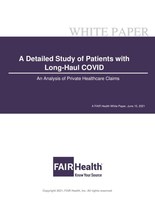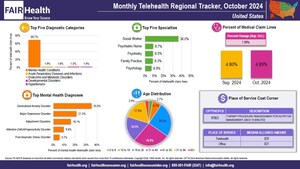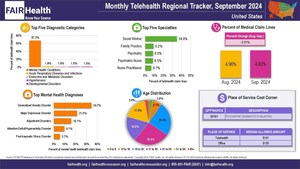Nineteen Percent of Asymptomatic COVID-19 Patients Develop Long-Haul COVID
Pain, Breathing Difficulties and Hyperlipidemia among the Most Common Post-COVID Conditions across All Ages
Odds of Death 30 Days or More after COVID-19 Diagnosis Are 46 Times Higher for Patients Hospitalized and Discharged Than for Non-Hospitalized COVID-19 Patients
NEW YORK, June 15, 2021 /PRNewswire/ -- Nineteen percent of COVID-19 patients without symptoms went on to exhibit at least one of the post-COVID conditions known as long-haul COVID 30 days or more after their initial COVID-19 diagnosis.1 This is among the findings in FAIR Health's new white paper, the eighth of its COVID-19 studies, A Detailed Study of Patients with Long-Haul COVID: An Analysis of Private Healthcare Claims. The report uses FAIR Health's repository of private healthcare claims data to study 1,959,982 COVID-19 patients—the largest population of COVID-19 patients ever studied for long-haul COVID—over the period from February 2020 to February 2021.
Although many patients recover from COVID-19 within a few weeks, some exhibit persistent or new symptoms more than four weeks after first being diagnosed. Names for such post-COVID conditions include not only long-haul COVID but long COVID, post-COVID syndrome or post-acute sequelae of COVID-19 or of SARS-CoV-2 (PASC).
Findings about long-haul COVID reported in FAIR Health's white paper include:
- The five most common post-COVID conditions across all ages, in order from most to least common, were pain, breathing difficulties, hyperlipidemia, malaise and fatigue, and hypertension.
- The odds of death 30 days or more after initial diagnosis with COVID-19 were 46 times higher for patients who were hospitalized with COVID-19 and discharged than patients who had not been hospitalized. Of COVID-19 patients who were hospitalized and discharged, 0.5 percent died 30 days or more after their initial diagnosis.
- Among COVID-19 patients with preexisting conditions, intellectual disabilities were associated with the highest odds of death 30 days or more after initial COVID-19 diagnosis.
- In addition to asymptomatic patients, those presenting with post-COVID conditions included 27.5 percent of COVID-19 patients who were symptomatic but not hospitalized, 50 percent of hospitalized patients and 23.2 percent of all patients who had COVID-19.
- The ranking of the most common post-COVID conditions varied by age group. For example, in the pediatric population (0-18), pain and breathing difficulties were the top two conditions, as in the all-ages cohort, but intestinal issues, rather than hyperlipidemia, were the third most common.
- Most of the post-COVID conditions that were evaluated were associated more with females than males. In the case of 12 conditions, however, males more commonly had the condition diagnosed than females. For example, of patients who had post-COVID cardiac inflammation, 52 percent were male and 48 percent female. By age, the largest share (25.4 percent) with this cardiac condition was found in a young cohort—individuals aged 19-29.
- Of the four mental health conditions evaluated as post-COVID conditions, anxiety was associated with the highest percentage of patients after COVID-19 in all age groups. Depression was second, adjustment disorders third and tic disorders fourth.
FAIR Health President Robin Gelburd stated: "Even as the COVID-19 pandemic wanes, long-haul COVID persists as a public health issue affecting many Americans. The findings in our new study shed significant light on this emerging issue for all individuals who have long-haul COVID, as well as for policy makers, providers, payors and researchers."
This is the eighth in a series of studies released by FAIR Health on the COVID-19 pandemic. The first study examined projected US costs for COVID-19 patients requiring inpatient stays, the second the impact of the pandemic on hospitals and health systems, the third the impact on healthcare professionals, the fourth key characteristics of COVID-19 patients, the fifth the impact on the dental industry, the sixth risk factors for COVID-19 mortality and the seventh the impact on pediatric mental health.
For the new white paper, click here.
Follow us on Twitter @FAIRHealth
About FAIR Health
FAIR Health is a national, independent nonprofit organization that qualifies as a public charity under section 501(c)(3) of the federal tax code. It is dedicated to bringing transparency to healthcare costs and health insurance information through data products, consumer resources and health systems research support. FAIR Health possesses the nation's largest collection of private healthcare claims data, which includes over 34 billion claim records and is growing at a rate of over 2 billion claim records a year. FAIR Health licenses its privately billed data and data products—including benchmark modules, data visualizations, custom analytics and market indices—to commercial insurers and self-insurers, employers, providers, hospitals and healthcare systems, government agencies, researchers and others. Certified by the Centers for Medicare & Medicaid Services (CMS) as a national Qualified Entity, FAIR Health also receives data representing the experience of all individuals enrolled in traditional Medicare Parts A, B and D; FAIR Health includes among the private claims data in its database, data on Medicare Advantage enrollees. FAIR Health can produce insightful analytic reports and data products based on combined Medicare and commercial claims data for government, providers, payors and other authorized users. FAIR Health's systems for processing and storing protected health information have earned HITRUST CSF certification and achieved AICPA SOC 2 compliance by meeting the rigorous data security requirements of these standards. As a testament to the reliability and objectivity of FAIR Health data, the data have been incorporated in statutes and regulations around the country and designated as the official, neutral data source for a variety of state health programs, including workers' compensation and personal injury protection (PIP) programs. FAIR Health data serve as an official reference point in support of certain state balance billing laws that protect consumers against bills for surprise out-of-network and emergency services. FAIR Health also uses its database to power a free consumer website available in English and Spanish, which enables consumers to estimate and plan for their healthcare expenditures and offers a rich educational platform on health insurance. An English/Spanish mobile app offers the same educational platform in a concise format and links to the cost estimation tools. The website has been honored by the White House Summit on Smart Disclosure, the Agency for Healthcare Research and Quality (AHRQ), URAC, the eHealthcare Leadership Awards, appPicker, Employee Benefit News and Kiplinger's Personal Finance. FAIR Health also is named a top resource for patients in Dr. Marty Makary's book The Price We Pay: What Broke American Health Care—and How to Fix It and Elisabeth Rosenthal's book An American Sickness: How Healthcare Became Big Business and How You Can Take It Back. For more information on FAIR Health, visit fairhealth.org.
Contact:
Rachel Kent
Senior Director of Marketing, Outreach and Communications
FAIR Health
646-396-0795
[email protected]
1 The classification of patients as asymptomatic in FAIR Health's analysis is based on claims data. Patients listed as asymptomatic may have experienced symptoms but not have incurred a claim regarding those symptoms.
SOURCE FAIR Health

Related Links
WANT YOUR COMPANY'S NEWS FEATURED ON PRNEWSWIRE.COM?
Newsrooms &
Influencers
Digital Media
Outlets
Journalists
Opted In







Share this article